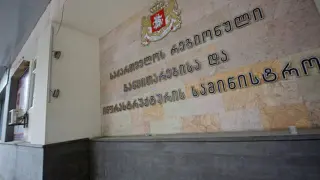Irakli Kobakhidze has announced that the Ministry of Regional Development and Infrastructure will be split into two separate entities. He stated that regional funding has increased alongside economic growth in recent years, making efficient planning and monitoring of regional development crucial for the country’s broader socio-economic progress. The government comprises the Prime Minister and 13 ministries as of 2 April 2025 at the time of the statement. Following this division, the number of ministries will rise to 14.
The number of ministries was initially reduced multiple times under the Georgian Dream’s governance before gradually increasing again, with previously merged ministries being re-separated. In contrast to the fluctuating number of ministries, public sector employment has shown a nearly constant upward trend. Furthermore, salaries in the public sector have also continued to grow, with a few exceptions.
Several ministries were merged with the objective of optimisation in 2017 under the Prime Ministership of Giorgi Kvirikashvili – the Ministry of Energy was incorporated into the Ministry of Economy and Sustainable Development, the Ministry of Environmental Protection was merged with the Ministry of Agriculture, the functions of the Ministry of Sports and Youth were distributed between the Ministries of Education and Culture whilst the Division of the State Ministry for European and Euro-Atlantic Integration was placed under the Ministry of Foreign Affairs. Consequently, the number of ministries was reduced from 18 to 14. However, this reduction was largely formal, as the number of individuals employed and ministry expenses remained practically unchanged.
The Ministry of Internally Displaced Persons from the Occupied Territories, Accommodation and Refugees was merged with several institutions, primarily the Ministry of Labour, Health and Social Affairs in 2018, during Mamuka Bakhtadze’s tenure as Prime Minister. The Ministry of Corrections was incorporated into the Ministry of Justice whilst the Ministry of Culture and Sports was combined with the Ministry of Education and Science.
The Ministry of Culture and Sports was once again separated from the Ministry of Education at the end of 2020 under the Prime Ministership of Giorgi Gakharia. This Ministry was then further divided into independent entities starting in 2025.
There were 19 ministries in October 2012 (including the State Minister’s Offices and the Ministry of employment established in 2012), 18 from 2013 to 2017, 14 in early 2018 but later downd to 11 until 2021. The number increased to 12 between 2021 and 2024 and rose to 13 in January 2025. Finally, the number of ministries will increase to 14 following the upcoming changes.
Graph 1: Number of Ministries including the Office(s) of the State Minister of Georgia
Source: Government of Georgia
The fluctuation in the number of ministries alone does not fully reflect the overall of the government of the scale of bureaucracy. Notably, public sector employment and total remuneration mainly followed an increasing trend from 2013 to 2024.
The latest available data on employment by types of ownership dates to 2023. The number of public sector employees increased by 27%, rising from 252,000 to 321,000, whilst employment in the non-public sector grew by just 7% – from 954,000 to 1.014 million between 2013 and 2023. When comparing post-pandemic figures, public sector employment rose by 7% in 2023 as compared to 2019, whereas non-public sector employment grew by merely 2%. Furthermore, the share of public sector employees relative to total employment constituted 21% in 2013, rising to 23% in 2019 and 24% in 2023. The proportion was even higher in 2021; however, this was primarily due to a decline in private sector employment due to the pandemic and related restrictions.
The figures above encompass all individuals employed in the public sector, including those working in ministries, self-governments, legal entities under public law (LEPLs), non-entrepreneurial non-commercial legal entities (NNLEs) and other state agencies.
Graph 2: Distribution of Employees by Types of Ownership
Source: National Statistics Office of Georgia
The number of contractors and their remuneration have risen significantly in recent years. Namely, contractor payments increased from GEL 91 million in 2013 to GEL 593 million in 2024, reflecting a 552% growth, according to the Institute for Development of Freedom and Information. Total labour remuneration expenditure grew by 118% between 2013 and 2024 – rising from GEL 1.19 billion to GEL 2.59 billion, according to State Treasury reports.
The pace of labour remuneration growth has been uneven, accelerating sharply in recent years. Salary expenses grew by 39% (from GEL 1.19 billion to GEL 1.65 billion) between 2013 and 2023. However, the growth rate constituted 57%, with salary expenditure reaching GEL 2.59 billion in 2024 as compared to 2021. This acceleration was mainly driven by two key factors: the rising number of public sector employees and increasing nominal wages. The government planned an annual wage increase of at least 10% from 2023 to 2025 to narrow the wage gap between public and private sector employees. However, the actual rise in labour remuneration expenses amounted to 22% in 2023 and 19% in 2024. Furthermore, wage expenses are projected to further increase by 17%, reaching GEL 3.03 billion. Considering 2025 projections, total spending is set to rise by 41% between 2021 and 2025 whilst labour remuneration costs alone will have increased by 84%.
Graph 3: Labour Remuneration Expenses in the State budget (GEL Billion)
Source: Ministry of Finance
There is no universal consensus on the ideal of government and bureaucracy. Most economists advocate for a smaller government with lower taxes, minimal regulation and reduced functional overhead. However, an alternative perspective suggests that increased regulation can enhance social welfare outcomes. Despite these differing viewpoints, there is broad agreement on certain aspects – namely efficiency. Public sector employees should have specific roles and should not be hired solely to increase employment figures. Moreover, their work should serve the interests of the state rather than those of a political party.
The optimal number of ministries, the appropriate of the workforce within them and the remuneration of civil servants – along with whether bureaucratic expansion aligns with publicly stated goals or serves narrow party interests – are all extensively researched but go beyond the scope of this article. However, several key facts can be highlighted:
- The Georgian Dream’s approach regarding the number of ministries is inconsistent – this number decreased at times only to rise again over the years, with ministries being merged and later split once again.
- Even when ministries were merged for the objective of efficiency, overall expenses did not significantly decrease. Furthermore, the number of employees within the newly combined ministries remained largely unchanged apart from the elimination of ministerial positions.
- The number of employees across all state institutions grew substantially between 2013 and 2023.
- The growth of both the number of public servants and their salaries has accelerated in recent years.
Amidst inflation and economic growth, overall budget expenditures – alongside bureaucratic costs – have increased, both in nominal and real terms. However, budgetary expansion is subject to constraints under the Organic Law of Georgia on Economic Freedom. The ratio of total expenditures and non-financial asset growth within the consolidated budget (comprises the state budget and the budgets of autonomous republics and local governments) must not exceed 30% of the GDP, according to Article 2, Paragraph 1 of the law.







